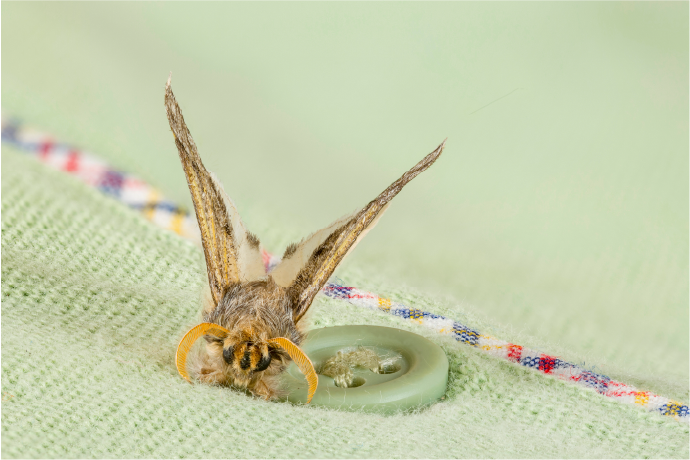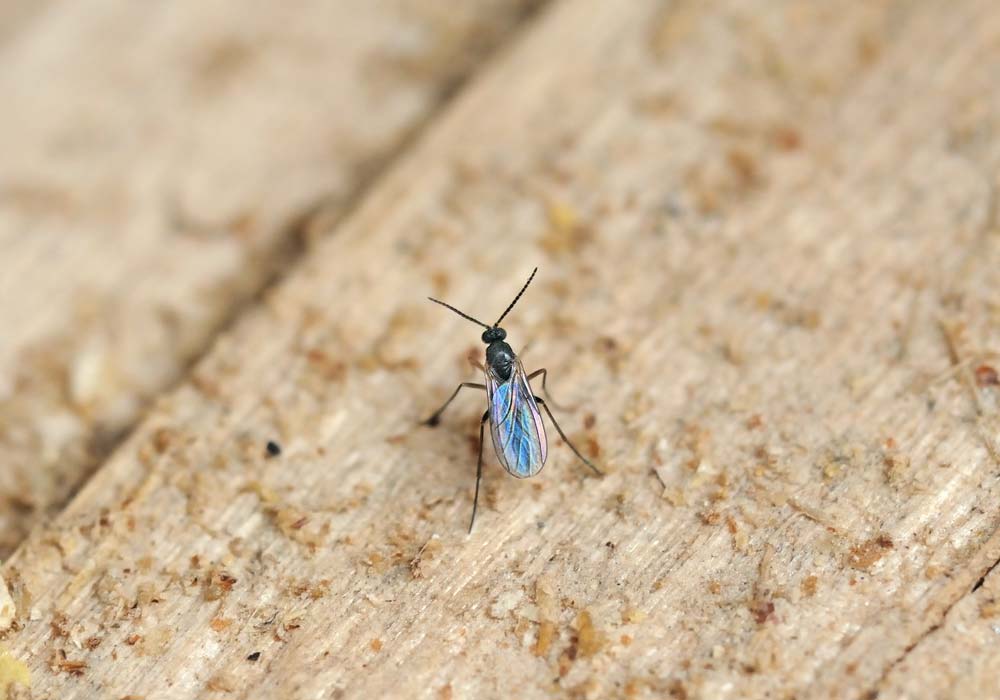The clothes moth (Tineola bisselliella) is a common household pest that feeds on the fibres in clothing, carpets and furnishings. They're most active May till October, and can be dealt with using parasitic wasps and pheromone traps.

Clothes Moth Quick Facts
What do clothes moth eat?
It’s actually the larvae form that feeds, not the adult moth.
Do moths eat clothes? Yes, they prefer the fibres in wool, fur, silk, feathers, felt and leather, but can eat any types of fibres, including cotton and carpets.

Wool fibres
This is because all these substances contain keratin, which is a fibrous protein the larvae can digest.
They can also feed on your produce indoors.
They like dark and undisturbed places, so they’re common in wardrobes, drawers and chests, particularly where clothes are stored for long periods of time without use. For example, your winter wardrobe or clothes you rarely wear.
For this reason, they’re particularly prevalent in large, stately homes and storage facilities. So much so English Heritage launched a monitoring programme across UK homes in 2017, and the National Trust are trialling a pest control programme
Believe it or not, clothes moth can also survive in the wild, where the larvae can feed on keratin in dead animals or nesting materials.
Can clothes moth eat cotton?
Clothes moth can also feed on cotton and polyester, especially if they’re blended with something like wool, or soiled with body oil or stains.
Symptoms of clothes moth
Clothes moth are very small and pale, and hide in dark places, so they may be hard to see.
The first symptom you’ll probably spot is tiny holes in your clothing, or thinner patches in your carpets, curtains, rugs or furnishings.

Moth holes
These holes get bigger over time as the larvae grows and eats more.
Clothes moth larvae also produce white webbing, which they feed under. They may leave trails of this behind.
Clothes moth lifecycle
Clothes moth usually live around 1 month, and lay 40-50 eggs on fabrics in dark, undisturbed places. These white eggs are tiny and invisible to the human eye.

Clothes Moth Lifecycle
The eggs usually hatch after just 4-10 days, with white larvae emerging. These start off just a few millimetres long but grow in length up to 10mm.
The ravenous larvae start munching on the fibres close to them. Unfortunately, these larvae can live an incredibly long time, up to 30 months in some cases. Usually they live just a few months.
Eventually, they form a cocoon in order to mutate into the adult moth form. When the adult emerges, it looks to mate and lay eggs, starting the process again.
When are clothes moth active?
Clothes moth are most active from May until October, when temperatures are 15-35°C.

Clothes moth
They’re most popular in Spring, when temperatures rise and clothes moth start to emerge and breed.
However, due to central heating, clothes moth can be active in winter time as well.
How to treat clothes moth
The best way to treat clothes moth naturally is through the use of parasitic wasps and pheromone traps.
Trichogramma parasitic wasps
The idea of using wasps can sound scary, but these are not the kind of wasps you see buzzing around your garden.
They’re a different species altogether, a pale microscopic parasite called Trichogramma evanescens.

Trichogramma wasp
Just 0.4mm in length, these wasps are invisible to the human eye, and natural predators of clothes moth eggs.
You can buy Trichogramma Evanescens in the UK on a small card called a Clothes Moth killer.
One card, about the size of your credit card, contains around 2,400 wasps.

Clothes moth killer card
The card comes in a sealed packet. Once opened, the wasps seek out the moth eggs by themselves.
As you can imagine, this is much easier than trying to spray every piece of fabric that clothes moth eggs might be on.
They come with a handy hole to hook on hangers, or alternatively you can just place them in drawers or on the floor.

Clothes moth card hanging in wardrobe
The great thing about these cards is that the wasps replicate themselves, actually within the clothes moth eggs.
They lay their eggs inside the clothes moth eggs, killing the developing clothes moth larvae and preventing it from hatching.
Since it’s the clothes moth larvae that actually eat your clothes, this is super effective.
More wasps then hatch out of the clothes moth egg, who hunt down even more eggs until there are none left.

How the Clothes Moth Killer works
Will the wasps bother me?
People often worry about releasing another live ‘animal’ into their home, but you actually won’t notice they’re there. They’re microscopic, and only a predator to clothes moth. They also don’t sting, and once the clothes moth infestation is taken care, the wasps will naturally die out also.
The truth is, biological treatments like this are a great, natural, effective alternative to insecticide sprays, which release chemicals into your home that last a lot longer and are much more dangerous to human and pet health, not to mention the environment.
Pheromone traps
For a two-pronged attack, it’s best to use pheromone traps as well.

Clothes moth pheromone trap
These target the adult moths, instead of the larvae, so you can tackle both life stages and stop an infestation in its tracks.
These are also natural. They give off the natural pheromone that females moth exude, attracting the male moth.

How a Clothes Moth pheromone trap works
The traps are sticky, so once inside, the moths get caught and die.

Dead clothes moth caught on sticky pheromone trap
You can buy the two natural pest controls together as a kit here.

Clothes moth killer kit
Other treatments
Moth balls containing naphthalene, a pesticide, used to be a common way of dealing with clothes moth, but this was banned in 2008 as it was found to be highly toxic.
Natural moth balls containing scents like lavender are now more popular, however they have limited effectiveness and only deal with the adult life stage.
Pesticide sprays are available, for example cypermethrin, a neurotoxin, but these contain chemicals and only work if they come into direct contact with the moth eggs, which is difficult when you don’t know where they are across a house full of clothes, carpet and furnishings.
Heat or freeze treatments are another effective chemical-free treatment and can be applied professionally, for example to clothes or a removable rug. You can also try this at home by freezing them at at least -18°C in freezer bags for two weeks.
How to prevent a clothes moth infestation
Regular cleaning and shaking out your clothes is the best way to prevent a clothes moth infestation.
Moths hate being disturbed, so making sure you regularly move furniture around and vacuum underneath them, as well as air rugs and clothing, is your best best. Take out clothes and shake them every month, and check for tiny holes.
If you don’t want to constantly check for tiny holes, you could buy a pheromone trap for monitoring.
Since these traps only attract clothes moth, and you can visibly see if any are caught, it’s also a great monitoring tool to alert you to if you have a clothes moth problem, so you can catch it early before your clothes are ruined.
If you have clothes you never wear, or want to store your winter clothes over the summer, one option is to vacuum-seal them, or use moth-proof breathable storage bags.
Related Products
CLOTHES MOTH KILLER CARD

Biological control of clothes moth using Trichogramma parasitic wasps. Free next day delivery.
CLOTHES MOTH KIT

Trap and card to tackle both life stages. Free next day delivery.


